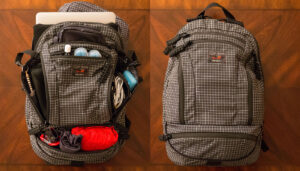Your specific packing list for a hiking adventure will depend on several factors, including weather conditions, difficulty, and distance from assistance. At minimum, though, always carry essential systems: Navigation aids can be essential when planning and engaging in outdoor activities, including hiking. They include paper maps, compasses, and GPS devices that have been charged and tested.
1. Water
As with any hiking trip, water should always be an integral component. Plan to bring one liter per hour of hiker activity when in moderate temperatures. Your trail trip must include an effective means for treating water, such as a filter or chemical treatment solution, in case any unexpected issues arise during your trek. Be sure to pack extra liters for emergencies!
An emergency communication device like the Garmin InReach Mini 2 can be invaluable on the trail. Not only will you be able to contact loved ones should something go wrong while out, but you’ll also have an SOS signal ready if anything should arise that needs urgent assistance.
2. Food
Food is one of the 10 essentials for hiking enthusiasts, whether planning for an overnight trek or just day hiking. No matter your plans, fueling up is absolutely crucial – choosing snacks that provide both micro- and macronutrients is recommended, like Veloforte Energy Chews, which can provide energy without the sugar crash!
Plan meals that require minimal cooking tools and utensils in order to minimize pack weight. Snacking at regular intervals instead of three large set meals each day is the optimal approach; it reduces digestive stress while helping you sustain energy for longer.
3. Maps
Paper or digital, maps are indispensable tools for hikers. They allow hikers to pre-plan trail routes and anticipate potential obstacles along their journey; additionally, maps provide backup navigational resources when GPS watches or smartphones lose power or connectivity.
Experienced hikers frequently use topographic maps, also known as contour lines, to navigate their surroundings. Becoming acquainted with map scales, symbols, and usage is vital to effective navigation on a trail; additionally, it’s crucial to learn how to interpret a compass – both skills can come in handy during an emergency situation.
4. Compass
Compasses are indispensable when hiking unmarked trails. In addition, they assist with navigation when exploring unfamiliar territory. Your compass should point towards magnetic north, which differs from true north (the North Pole). To take a bearing, place it with its base plate facing upward and rotate its rotating bezel until its index line lines up with its orienting arrow.
Select a landmark either on the ground or on the map, and point the direction-of-travel arrow at it. Rotate the compass until its magnetized needle falls within the red outline of an orienting arrow.
5. Sunscreen
Sunscreen should always be included on a hiking adventure to protect your skin from harmful UV rays that can cause sunburns and long-term damage.
Sun protection is particularly crucial for thru-hikers who will spend long days exposed to bright, sunny conditions. Starting your hike early and wearing clothing that provides UV sun protection are great ways to lessen exposure. Bring along a flashlight, extra batteries, and a fully charged cell phone as part of the Ten Essentials, an assortment of safety items developed by outdoor groups.
6. First-Aid Kit
Hikers should bring along a first-aid kit on every hiking adventure. Depending on the length and difficulty of their trip and individual medical requirements, their first-aid kits may vary greatly in terms of contents. Key items for emergency first responders in an accident include a waterproof notepad for recording vital details such as names, locations, and injuries; air-activated hand warmers; and personal medication like ibuprofen or antihistamines.
DIY first-aid kits allow hikers to tailor their kit specifically to themselves by including medications and supplies specific to each hiker. Prepackaged first-aid kits may save space; however, creating your own DIY first-aid kit gives hikers an opportunity to add personal items.
7. Sleeping Bag
Sleeping bags are an integral component of any hiking kit, particularly those for cold-weather hiking trips. A sleeping bag should have an insulation rating lower than your expected low temperatures; however, its temperature rating alone does not guarantee survival at those temperatures without additional layers of warmth, an insulated pad, and wind/rain protection such as tarpaulins or bivvies.
A backpacking sleeping bag should be lightweight, compact, and capable of withstanding subzero conditions. In addition, a hood should help retain heat. Synthetic fiber sleeping bags offer superior moisture resistance compared to down and are generally allergy-friendly.
8. Sunglasses
Sunglasses are essential hiking gear, providing protection from UV rays and glare while making it easier to see ahead on the trail. In addition, sunglasses also protect eyes from dust, wind, insects, and debris in the form of dustbins or insects that might fall onto them during a hike.
Polarized lenses that reduce glare and improve visual clarity during hikes should fit comfortably on your face, ideally with wraparound frames for optimal protection. Bring an extra pair of sunglasses just in case the primary pair breaks or gets lost during your trek. Consider choosing polycarbonate lenses for durability. Additionally, it would be wise to purchase sunglasses that provide full UV ray protection of up to 400 nanometers.
9. Warm Clothing
On your hike, it is crucial that you are prepared for all types of weather conditions. Even when the sky appears clear and warm, cold air may settle at higher altitudes in the morning and evening hours.
Insulating layers such as down feathers or synthetic fabrics help your body retain heat by decreasing radiative heat loss. Clothing should be moisture-wicking to keep skin dry and prevent sweat chafing, resulting in skin irritation or discomfort. An essential piece for hiking trips is a waterproof jacket. From rain or snowstorms, its protection can protect both yourself and your gear while saving lives in an emergency evacuation situation.




